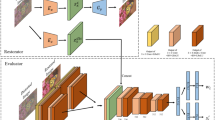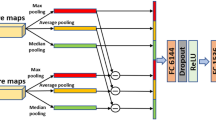Abstract
Measurement of visual quality is of significant importance to many image processing tasks. The target of image quality assessment (IQA) is to design effective computational models in order to automatically predict the quality of images in a perceptual consistent manner. We propose a full reference (FR) IQA metric based on deep convolutional neural networks and information-theoretic IQA framework. The previous proposed PAVIF is incorporated into the powerful convolutional network VGG19. Both the reference and distorted image are fed into the VGG19, and the output of each channels in the first 35 layers are utilized to measure the perceptual quality difference. The final objective score is obtained by averaging all the channel-wise quality scores. Experimental results on TID2013 and LIVE image database demonstrate that our proposed metric is competitive with many state-of-the-art IQA metrics.








Similar content being viewed by others
References
Chandler DM (2013) Seven challenges in image quality assessment: past, present, and future research. IRSN Signal Process 2013:53
Gao F, Wang Y, Li P et al (2017) DeepSim: deep similarity for image quality assessment[J]. Neurocomputing 257:104–114
Hou W, Gao X, Tao D, Li X (2015) Blind image quality assessment via deep learning. IEEE Trans Neural Netw Learn Syst 26(6):1275–1286
Kim J, Lee S (2017) Fully deep blind image quality predictor. IEEE J Sel Topics Signal Process 11(1):206–220
Kim J, Lee S (2017) Deep Blind Image Qualtiy Assessment by Employing FR-IQA, IEEE Conference on Image Processing, 3180–3184
Larson EC, Chandler DM (2010) Most apparent distortion: full-reference image quality assessment and the role of strategy. Journal of Electronic Imaging 19(1):011006-011006-21
Liaw A, Wiener M (2002) Classification and regression by randomForest[J]. R news 2(3):18–22
Liu TJ, Lin W, Kuo CC (2013) Image quality assessment using multi-method fusion. IEEE Tran Image Process 22(5):1793–1807
Ma X, Jiang X (2017) PA VIF: A passive aggressive visual information fidelity for full reference image quality assessment[C]//Telecommunication Networks and Applications Conference (ITNAC), 2017 27th International. IEEE, 1–6
Oszust M (2016) Decision fusion for image quality assessment using an optimization approach. IEEE Signal Process Lett 23(1):65–69
Pei SC, Chen LH (2015) Image quality assessment using human visual DoG model fused with random forest. IEEE Trans Image Process 24(11):3282–3292
Ponomarenko N (2014) Color image database TID2013: Peculiarities and preliminary results, in Proc. 4th Eur. Workshop Vis. Inf. Process., 106–111
U. Rajendra Achary, YukiHagiwara, Sunny Nitin Deshpande, S. Suren, Joel En Wei Koh, Shu Lih Oh, N. Arunkumar, Edward J. Ciaccio, Choo Min Lim., "Characterization of focal EEG signals: a review"., Futur Gener Comput Syst, Vol. 91, 2019, pg. 290–299
Sheikh HR, Bovik AC (2005) An information fidelity criterion for image quality assessment using natural scene statistics. IEEE Tran. Image Process. 14(12):7117–2128
Sheikh HR, Bovik AC (2006) Image information and visual quality. IEEE Tran. Image Process. 5(2):430–444
Sheikh HR, et.al ‘LIVE image quality assessment database release_2’. http://www.live.ece.utexas.edu/research/quality
Sheikh HR, Sabir MF, Bovik AC (2006) A statistical evaluation of recent full reference image quality assessment algorithms[J]. IEEE Trans Image Process 15(11):3440–3451
Simonyan K, Zisserman A. (2014) Very deep convolutional networks for large-scale image recognition[J]. arXiv preprint arXiv:1409.1556
Wang Z, Bovic AC (2006) Modern image quality assessment. Synth Lect Image, Video, Multimedia Process 22(1):1–156
Wang Z, Bovik AC (2002) A universal image quality index[J]. IEEE signal processing letters 9(3):81–84
Wang Z Bovik ZAC (2003) “Multiscale structural similarity for image quality assessment”, Asilomar Conf. Signals, Syst. Comput., 1398–1402
Wang Z, Li Q (2011) Information content weighting for perceptual image quality assessment. IEEE Trans Image Process 20(5):1185–1198
Wang Z, Bovik AC, Sheikh HR et al (2004) Image quality assessment: from error visibility to structural similarity. IEEE Tran. Image Process. 13:600–612
Wang H, Fu J, Lin W et al (2017) Image quality assessment based on local linear information and distortion-specific compensation. IEEE Trans Image Process 26(2):915–926
Xue W, Zhan L, Mou X et al (2014) Gradient magnitude similarity deviation: a highly efficient perceptual image quality index. IEEE Trans Image Process 23(2):684–695
Zhang L, Li H (2012) SR-SIM: A fast and high performance IQA index based on spectral residual, in Proc. IEEE Int. Conf. on Image Processing (ICIP), IEEE
Zhang L, Zhang L, Mou X et al (2011) FSIM: a feature similarity index for image quality assessment. IEEE Trans Image Process 20(8):2378–2386
Zhang L, Shen Y, Li H (2014) VSI: a visual saliency-induced index for perceptual image quality assessment. IEEE Trans on Image Process 23(10):4270–4281
Author information
Authors and Affiliations
Corresponding author
Additional information
Publisher’s note
Springer Nature remains neutral with regard to jurisdictional claims in published maps and institutional affiliations.
Rights and permissions
About this article
Cite this article
Ma, X., Jiang, X. Multimedia image quality assessment based on deep feature extraction. Multimed Tools Appl 79, 35209–35220 (2020). https://doi.org/10.1007/s11042-019-7571-y
Received:
Revised:
Accepted:
Published:
Issue Date:
DOI: https://doi.org/10.1007/s11042-019-7571-y




